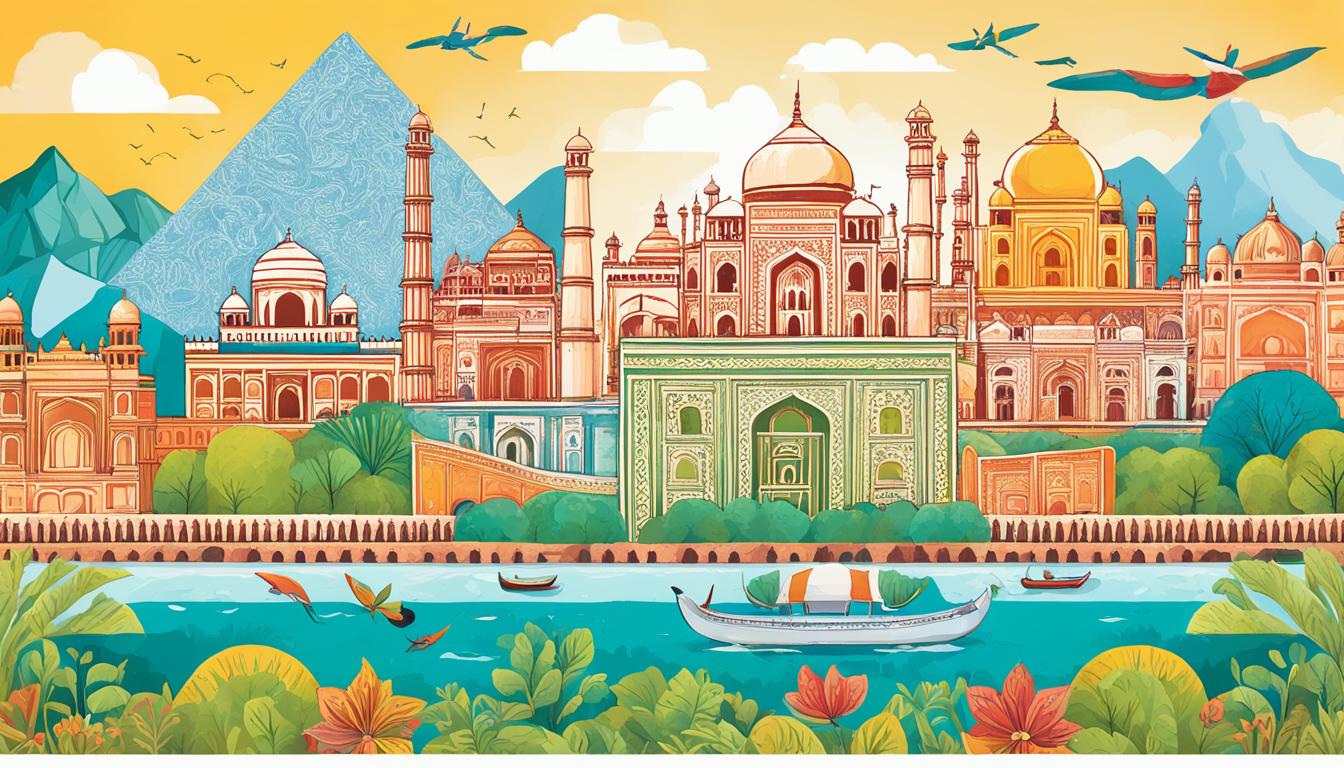Did you know that India is home to over 1.3 billion people, making it the second most populous country in the world? With such a vast population, it’s no wonder that India is a land of remarkable diversity and vibrant cultural traditions. One of the best ways to experience this diversity is by exploring the contrasting regions of North and South India.
Imagine yourself standing in front of the iconic Taj Mahal, its white marble facade glowing in the soft morning light. Or picture yourself taking a leisurely cruise through the tranquil backwaters of Kerala, surrounded by lush greenery and the gentle lapping of water. These are just a glimpse of what awaits you in this magical country.
Whether you’re drawn to the architectural wonders of the north, the tropical landscapes of the south, or the rich cultural heritage found throughout India, deciding between North and South India can be a tough choice. Let’s dive into the unique characteristics of each region to help you make an informed decision and create memories that will last a lifetime.
Key Takeaways:
- India’s rich cultural heritage and diversity make it an incredible travel destination.
- North India is known for its architectural wonders and iconic landmarks like the Taj Mahal.
- South India offers tropical landscapes, serene backwaters, and vibrant cultural traditions.
- The decision between North and South India depends on your interests and the kind of experience you’re seeking.
- Exploring both regions can give you a comprehensive understanding of India’s diverse culture.
Weather and Climate

One of the key factors to consider when planning a trip to India is the weather and climate. The North and South regions of the country have distinct climatic conditions that can significantly impact your travel experience.
In North India, the weather varies between seasons. The region experiences a cool and dry winter season from November to February, making it an ideal time to visit if you prefer milder temperatures. Summers, on the other hand, can be scorching with temperatures reaching as high as 45°C (113°F). The Himalayas influence the weather patterns in North India, bringing cold winds and occasional snowfall during winters.
On the contrary, South India has a more tropical climate throughout the year. The region enjoys relatively warmer temperatures compared to the north, ranging from 20°C (68°F) to 35°C (95°F). Humidity is higher in South India, especially along the coastal areas. The state of Kerala experiences a secondary monsoon season, which brings heavy rainfall from June to September.
Whether you prefer cooler temperatures or warmer climates, understanding the weather and climate differences between North and South India can help you plan your trip accordingly. Keep in mind that both regions have their own unique charm and attractions, making it worthwhile to explore different parts of the country.
Language and Culture
India’s diversity is not only reflected in its geography and climate but also in its rich language and culture. The languages spoken in North India belong to the Indo-Aryan family, with Hindi being the most widely spoken language. Alongside Hindi, you’ll find other languages like Urdu and Punjabi. On the other hand, South India is known for its Dravidian languages such as Telugu, Tamil, Malayalam, and Kannada.
These languages are not just a means of communication; they are an integral part of the cultural identity of each region. They shape the literature, music, and art forms that have thrived in these areas for centuries.
Cultural Traditions
Indian culture is a tapestry woven with diverse traditions and customs. In North India, you’ll experience a blend of influences from Mughal, Rajput, and Sikh cultures. The region is known for its vibrant festivals like Diwali and Holi, where people come together to celebrate with music, dance, and colorful rituals. North Indian cuisine is famous for its rich flavors and aromatic spices, with dishes like biryani and butter chicken being popular delicacies.
In North India, the culture is characterized by its hospitality, warm-heartedness, and love for exuberant celebrations.
On the other hand, South India has a distinct cultural identity shaped by its Dravidian heritage. The region is renowned for its classical dance forms like Bharatanatyam and Kathakali, which mesmerize audiences with their intricate movements and expressive storytelling. The temple festivals in South India are a sight to behold, with elaborate processions, music performances, and traditional rituals.
South Indian culture emphasizes simplicity, spirituality, and devotion to the gods.
When it comes to cuisine, South Indian food is known for its diverse flavors and healthy ingredients. Rice is a staple in this region, and dishes like dosa, idli, and sambar are iconic culinary creations that have gained popularity worldwide.
You can also read: India’s Top 5 Travel Blogs
Cultural Diversity Uniting India
The variations in language and culture across different regions of India contribute to the country’s rich tapestry of diversity. This diversity is not a source of division, but rather a unifying force that binds the people together. It showcases the inclusivity and acceptance that define the essence of Indian society.
Whether you find yourself in the bustling streets of Delhi or the serene backwaters of Kerala, each region offers a unique cultural experience that is bound to leave a lasting impression.
Architecture and Temples
One of the most captivating aspects of North and South India is the architectural wonders showcased in their temples. From the majestic North Indian mandirs to the intricately carved structures of South Indian temples, each region offers a unique and awe-inspiring experience.
North Indian Architecture: Mandirs in Scenic Landscapes
The North Indian temples, often referred to as mandirs, exhibit a distinct architectural style influenced by the Nagara or Indo-Aryan tradition. These temples are typically smaller in size but hold immense spiritual significance. They are strategically located amidst scenic landscapes such as mountains or river banks, providing a serene and tranquil atmosphere for devotees.
The intricately crafted sculptures adorning the mandirs beautifully depict mythological stories and religious beliefs. The rich artwork and stone carvings are a testament to the skilled craftsmanship prevalent in North Indian architecture.
South Indian Architecture: Towering Gopurams and Intricate Designs
South Indian temples are renowned for their towering gopurams (gateways) and intricate architectural details. Influenced by the Dravida style, these temples are larger in size and often serve as the focal point of the towns and cities they reside in.
The gopurams, adorned with vibrant sculptures and intricate carvings, welcome devotees with their grandeur. As one explores the temple complex, they will come across pillared halls, pavilions, and additional shrines, each showcasing the unparalleled architectural prowess of the region.
“The architectural brilliance of South Indian temples leaves visitors in awe. The meticulous attention to detail and exquisite craftsmanship transport you to a realm of divine beauty.”
Temples as Spiritual Sanctuaries
Whether you visit North or South India, the temples hold immense spiritual significance for the locals and seekers of divine blessings. The tranquil ambiance, sacred rituals, and architectural splendor create a sense of reverence and devotion.
Exploring these temples gives visitors a glimpse into the rich cultural and religious heritage of India. The serene atmosphere and intricate architectural details make them ideal places for introspection, meditation, and spiritual rejuvenation.
| North Indian Architecture (Nagara or Indo-Aryan style) | South Indian Architecture (Dravida style) |
|---|---|
| Smaller temples | Larger temples |
| Located in scenic landscapes | Serve as city landmarks |
| Carved stone sculptures depicting mythology | Towering gopurams with intricate carvings |
| Nagara or Indo-Aryan influence | Dravida architectural style |
Clothing and Attire
India’s diverse culture is beautifully reflected in the traditional attire worn by people across the country. When it comes to clothing, North Indian and South Indian communities have distinct styles that showcase their rich heritage and regional preferences.
For North Indian women, the salwar kameez or churidar is a popular choice. These outfits consist of a loose-fitting tunic or kameez paired with trousers or salwar and a scarf called a dupatta. The salwar kameez is known for its vibrant colors, intricate designs, and elegant embroidery, making it a visually captivating ensemble.
On the other hand, South Indian women are often seen wearing sarees and half sarees, known for their bright and vibrant hues. The saree is a long piece of fabric draped around the body, while the half saree consists of a skirt, blouse, and a dupatta-like garment draped over the shoulder. These garments are adorned with intricate patterns and embellishments that add a touch of grace and elegance to the wearer.
When it comes to men’s clothing, North Indian men commonly wear pants, shirts, and kurtas. Kurtas are loose-fitting, knee-length shirts that can be paired with either pants or traditional pyjamas. This ensemble exudes a sense of sophistication and comfort, making it suitable for various occasions.
Meanwhile, men in South India often opt for dhotis or lungis. A dhoti is a long rectangular piece of cloth tied around the waist and draped elegantly, while a lungi is a similar garment but shorter in length and worn as a skirt.
These traditional garments reflect the simplicity and cultural identity of the region. You can also read: Maldives or Seychelles: Deciding Your Paradise
Influences and Significance
The clothing choices in North and South India are influenced by the region’s climate, cultural traditions, and historical influences. The North Indian attire is heavily influenced by Mughal and Persian styles, while South Indian clothing draws inspiration from the Dravidian culture.
The variety and diversity of traditional Indian attire reflect the country’s rich cultural tapestry. Every garment tells a story, showcasing the craftsmanship, traditions, and values of the communities that wear them.
“The traditional clothing of India reflects the vibrancy, heritage, and distinct identities of its different regions. Whether it’s the colorful sarees of South India or the elegant salwar kameez of the North, each garment carries a piece of India’s rich cultural history.”
Embracing Tradition
From lavish weddings and festivals to daily wear, traditional attire plays a significant role in Indian society. The intricate designs, vibrant colors, and careful craftsmanship make these garments a source of pride and cultural identity.
Whether you’re exploring the bustling streets of Delhi or enjoying the serene backwaters of Kerala, the sight of people in their traditional attire adds a touch of authenticity and charm to your Indian experience.
By embracing and appreciating the cultural significance of clothing in India, you not only gain a deeper understanding of its diverse heritage but also contribute to the preservation and celebration of this rich tradition.
Music and Dance
The rich cultural heritage of India is beautifully reflected in its diverse music and dance traditions. The country is known for its two major styles of classical music – Hindustani music in the North and Carnatic music in the South.
In North India, Hindustani music takes center stage. It is characterized by its melodic and improvisational nature, with a focus on intricate melodies and soul-stirring vocal performances. The region embraces a variety of instruments, including the sitar, sarangi, santoor, and tabla. These instruments, with their unique sounds and techniques, add depth and richness to the music.
On the other hand, the South Indian music tradition of Carnatic music is known for its emphasis on rhythm and intricate compositions. Instruments like the mridangam, veena, and violin are favored in this style. Carnatic music is highly regarded for its technical complexity and expressive performances, with a strong focus on intricate rhythmic patterns and melodic ornamentation.
Dance forms also play a vital role in the cultural fabric of India. In the North, the vibrant and energetic Kathak dance form captures the essence of storytelling through intricate footwork, graceful movements, and expressive facial expressions. Another popular dance form in the North is Bhangra, which showcases the joyous spirit of Punjab with its energetic and rhythmic movements.
In the South, Bharatanatyam takes center stage as one of the most ancient and revered dance forms. It is characterized by its complex footwork, hand gestures, and facial expressions, all performed in synchronization with the rhythm. Kathakali, another prominent South Indian dance form, is known for its elaborate costumes, vibrant makeup, and dramatic storytelling.
| North Indian Music | South Indian Music |
|---|---|
| Genre: Hindustani | Genre: Carnatic |
| Popular Instruments: Sitar, Sarangi, Santoor, Tabla | Popular Instruments: Mridangam, Veena, Violin |
Both North and South India hold their music and dance traditions close to their hearts. These art forms not only entertain but also serve as a means of storytelling, cultural preservation, and spiritual expression. They truly bring the soul of India to life.
Top Tourist Destinations
When it comes to tourist attractions, both North and South India have a plethora of fascinating destinations to explore. Whether you’re captivated by historical landmarks or breathtaking natural beauty, each region has its own unique charm that will leave you awe-struck.
North India
In North India, you’ll find iconic landmarks that are steeped in history and cultural significance. A visit to the Taj Mahal in Agra is a must. This breathtaking white marble mausoleum is not only a UNESCO World Heritage Site but also considered one of the New Seven Wonders of the World. The Red Fort in Delhi, with its impressive architecture and rich history, is another must-see attraction. And don’t forget to marvel at the serene Golden Temple in Amritsar, a sacred Sikh shrine that welcomes visitors from all walks of life.
Alongside these renowned landmarks, North India offers stunning hill stations that provide a refreshing escape from bustling city life. Shimla, nestled in the foothills of the Himalayas, offers picturesque views, colonial-era architecture, and pleasant weather. Meanwhile, the Pink City of Jaipur showcases the grandeur of Rajasthan with its majestic forts, palaces, and vibrant markets.
South India
South India boasts its own array of captivating tourist attractions. The Meenakshi Amman Temple in Madurai, Tamil Nadu, is renowned for its towering gopurams and intricate carvings. This ancient temple dedicated to the goddess Meenakshi is a testament to the architectural brilliance of South India. Further south, the backwaters of Kerala offer a tranquil experience as you cruise along serene water channels surrounded by lush greenery. And if you’re craving sun, sand, and sea, the beautiful beaches of Goa are an ideal destination.
Each region of South India also has its own unique charm. The temple town of Hampi in Karnataka showcases the remnants of the Vijayanagara Empire and is a UNESCO World Heritage Site. In Kerala, the hill station of Munnar entices visitors with its tea plantations, misty valleys, and panoramic views. And let’s not forget about the architectural marvels of Mahabalipuram near Chennai, where ancient rock-cut temples and monuments stand as testaments to South India’s rich history.
Whether you choose to explore the iconic landmarks of North India or immerse yourself in the natural beauty of South India, there’s no shortage of remarkable attractions to discover. Each region offers a unique tapestry of history, culture, and breathtaking landscapes that will mesmerize every traveler.
Conclusion

When deciding between visiting North or South India, it’s important to consider your interests and preferences. North India offers a rich cultural heritage, breathtaking architecture, and iconic landmarks such as the Taj Mahal and the Red Fort. Exploring the vibrant streets of Delhi and experiencing the spirituality at the Golden Temple in Amritsar are just a few highlights of North India.
On the other hand, South India welcomes you with its picturesque tropical landscapes, serene backwaters, and vibrant cultural traditions. From the majestic Meenakshi Amman Temple in Madurai to the tranquil backwaters of Kerala and the beautiful beaches of Goa, South India offers a unique blend of natural beauty and cultural experiences.
So, whether you are seeking a journey through history and architecture or a tropical escape filled with cultural festivities, both North and South India have something incredible to offer. The decision ultimately comes down to the kind of experience you’re looking for. Whichever region you choose, your travel adventure in India is bound to be unforgettable.
FAQ
What is the difference between North and South India?
North and South India differ in terms of weather, languages spoken, cuisine, architecture, clothing, music, dance, and tourist attractions.
What is the weather like in North India?
North India experiences cool and dry winters and hot summers, with weather patterns influenced by the Himalayas.
How is the weather in South India?
South India has a tropical climate with warmer temperatures throughout the year and higher humidity. It also experiences a secondary monsoon season in Kerala.
What languages are spoken in North India?
In North India, Indo-Aryan languages like Hindi, Urdu, and Punjabi are predominantly spoken.
What languages are spoken in South India?
South India is known for its Dravidian languages such as Telugu, Tamil, Malayalam, and Kannada.
What is the difference between North Indian and South Indian cuisine?
North Indian cuisine consists of wheat-based dishes and spicy curries, while South Indian cuisine is known for its rice-based dishes and the use of coconut and seafood.
How are the temples different in North and South India?
North Indian temples, known as mandirs, are usually smaller and located in scenic landscapes like mountains or riverbanks. South Indian temples have towering gopurams (gateways) and intricately carved structures.
What is the traditional attire in North India?
Women in North India often wear the salwar kameez or churidar, while men typically wear pants, shirts, and kurtas.
What is the traditional attire in South India?
South Indian women prefer brightly colored saris and half saris, while men often wear dhotis or lungis.
How does North Indian music differ from South Indian music?
North India is known for Hindustani music, while South India is famous for Carnatic music. The instruments and styles of these two classical music forms vary.
What are some popular tourist destinations in North India?
North India is home to iconic landmarks like the Taj Mahal in Agra, the Red Fort in Delhi, and the Golden Temple in Amritsar. It also offers stunning hill stations like Shimla and historic cities like Jaipur.
What are some popular tourist destinations in South India?
South India boasts attractions like the Meenakshi Amman Temple in Madurai, the backwaters of Kerala, and the beautiful beaches of Goa.
Which part of India should I visit?
The choice between North and South India depends on your interests and preferences. North India offers a rich cultural heritage, breathtaking architecture, and iconic landmarks, while South India is known for its tropical landscapes, serene backwaters, and vibrant cultural traditions. Both regions have their own unique charm and attractions.


